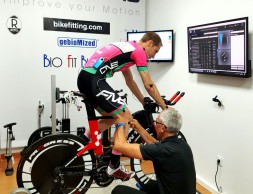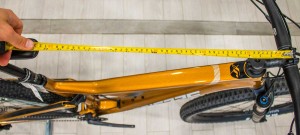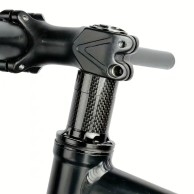How to adjust your bike to avoid injuries and ride more comfortably
The correct positioning of the cyclist on the bike is a key factor if we intend to spend many hours pedaling without suffering discomfort or making movements that could lead to injury. In addition, proper positioning will allow us to be more efficient on the bike. These are the main points you should keep in mind when adjusting your bike.

What are the most important measurements of the cyclist's position
Although more and more cyclists are taking into account their position on the bike by adapting it to their physical characteristics and, in many cases, putting themselves in the hands of a biomechanic to ensure the correct adjustment, it is still normal to see people pedaling in any way on their bikes: low saddles, handlebars too low, stretched out excessively, with saddles unsuitable for their physique and a host of biomechanical aberrations.
Luckily, cycling is not an aggressive sport and in most cases these placements do not end up being harmful although, yes, they are often the origin of many of the discomforts that are suffered on the bike and that, traditionally, have been considered an inherent evil to the hardness of cycling such as back and neck pain, chafing caused by friction with the saddle or numbness in different parts of the body.
RECOMENDADO

Some reasons to stay away from the road in winter

The best apps for cycling and mountain biking

Black Friday 2025 cycling bargains: save on Garmin, POC, Maxxis and more

Black Friday Garmin 2025: the ultimate guide to choosing your GPS at the best price

Do you need suspension on your gravel bike?

A real workout saver of only 56 min on the turbo trainer
Without intending to replace the work of a biomechanic, we leave you several tips on how to adjust the basic measurements of your bicycle to, at least, avoid injuries.
Saddle height
This is undoubtedly the main measure that affects pedaling. The rest of the dimensions can be adjusted but if we pedal with the saddle too high or too low we take the risk of injuring ourselves or, at least, suffering discomfort in the support areas and wasting a large part of the force we exert on the pedals.

There are many suggested ways to obtain this measure. From formulas that check the inseam length to more or less homemade methods that use some part of the body as a reference. You can see everything you need to take into account about saddle height in this article. Broadly speaking, sensations are often more clarifying than the formulas that are out there.
We will look for a position in which the knee is almost fully extended but without fully doing so. After that we will try to pedal and look for a finer adjustment depending on whether we perceive excessive pressure in the crotch or notice that it is difficult for us to exert force on the pedals.
Reach to the handlebar
When choosing the size of the bike, the reach, or the effective length of the cockpit, is the most decisive to assess whether the bike is suitable for us or not, especially with current bikes where integration with specific stems and internal cabling makes it very difficult to play with the length of this component to adjust this parameter.

And the way to adjust how far or close the handlebar is to us is to play with the length of the stem or the reach of the handlebar, having some margin with the setback of the saddle although we should not use this measure to make this adjustment as we will explain later.
The sensations that we should take into account to assess whether this distance is well adjusted is that we reach the levers naturally, with semi-flexed elbows and without feeling tension in the lower back or, if we go too short, in the upper part of the back and neck. Sensations that we should assess when we have been pedaling for at least a couple of hours since getting on and taking a small turn, with the body rested will not allow us to obtain real conclusions.
Saddle setback
Often this is a measure that few take into account and that, however, greatly affects the performance of pedaling. Going with the setback well adjusted is what makes it possible for the work to be properly distributed among all the muscles of the leg, the pedaling flows more easily without getting stuck at any point and we can exert force throughout the range.
That is why we should not use the setback of the saddle to adjust the distance to the handlebar as we will be affecting the way of pedaling, although we can always play with a small range to adapt this measure to our preferences and the type of saddle we carry. The latter is important since, traditionally, the setback has been measured taking as reference the tip of the saddle and the bottom bracket. However, the current cut saddles make these references change.

Instead, it is preferable to take into account the pivot point of the knee so that the force is applied perpendicularly on the pedal at the point of greatest force, that is, with the cranks horizontal. To do this, the usual method is to drop a plumb line from the pivot point of the knee, not from the kneecap as we often see, which should fall on the axis of the pedal.
When modifying the setback of the saddle we must bear in mind that, as the tube of the bike is angled, it will affect the height of the same. Therefore, we should correct this by slightly raising the saddle after moving it forward or lowering it if we have moved it back.
Difference in height between saddle and handlebar
Traditionally, road bikes were all competition machines, with the same aggressive measures used by professionals. Fortunately, on classic bikes the threaded steering system and wedge stems allowed for easy adjustment up and down in a similar way to how we would adjust the saddle.
The arrival of the ahead steering system brought many advantages in terms of mechanical simplicity and weight reduction but, it practically ended the possibility of adjusting the height of the handlebar. A height that can only be adjusted by playing with the spacers that can enter, placing them above or below the stem.

However, carrying excessive spacers has a clear impact on the precision of the steering and its rigidity as the stem is away from the upper bearing, apart from being clearly unsightly. It is also possible to modify this parameter with the inclination of the stem. Simply turning it over can gain quite a bit of height.
An excessive difference in height with the saddle will require the cyclist to excessively flex the hip, which results in a loss of force application in the upper part of the pedaling in addition to leading to discomfort in the back and crotch. Another consequence of carrying an excessive saddle height is the inability to use the curve of the handlebar, the point where we have the most control of the bike on descents or riding at high speed. On the contrary, going too high can cause discomfort in the neck in addition to clearly affecting aerodynamics.